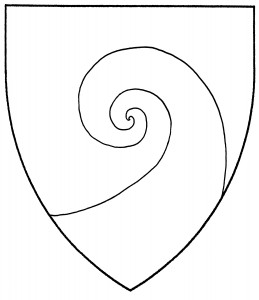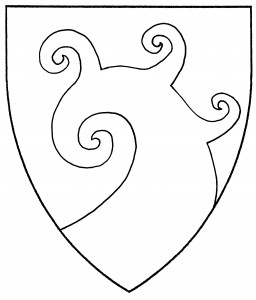A schnecke is a highly stylized charge from German heraldry, consisting of a tapering line spiraling inward from a point on the shield’s edge to its center. The term literally translates as “snail”, as its curve resembles that of the snail’s shell; in French blazon, it’s termed un gyron gironnant, “a spiraling gyron”.
The schnecke is a period charge, found in the arms of von Rordorf, 1605 [Siebmacher 198]. We have no period examples of its being charged, or used with other charges on the field; therefore, the use of a schnecke with secondary charges is considered a step from period practice, as is its use with tertiary charges.
The point at which the schnecke enters the shield should be blazoned; whether it spirals deasil or widdershins is left to the artist. The illustration shows a schnecke issuant from base.
An early-period variation on the schnecke depicts it with three smaller schneckes issuant from its outer curve. This form is found in the arms of Casteleynsche or Kestelinge, c.1370 [Gelre 110v], and appears to be unique to those arms.
For related charges, see gurges.
Peter Schneck bears: Sable, a schnecke issuant from dexter chief argent.
Leocadia de Bilbao bears: Argent, issuant from base a schnecke azure.
Marie de Blois bears as a badge: Or, a schnecke issuant from sinister base maintaining on the outer swirl three schneckes sable.

